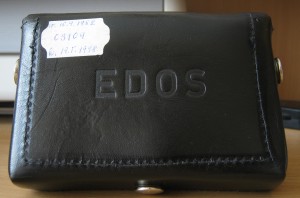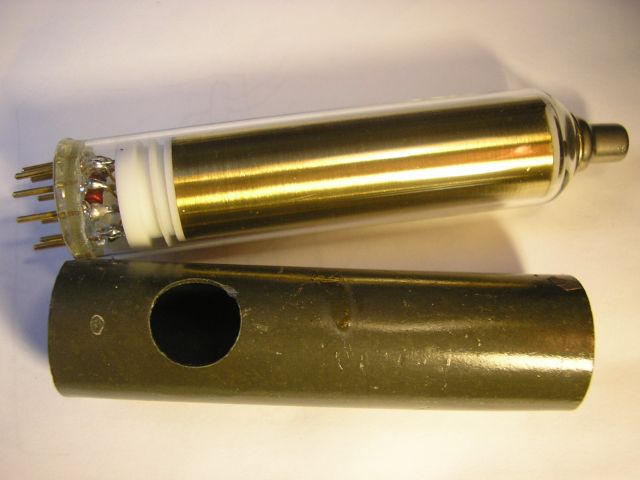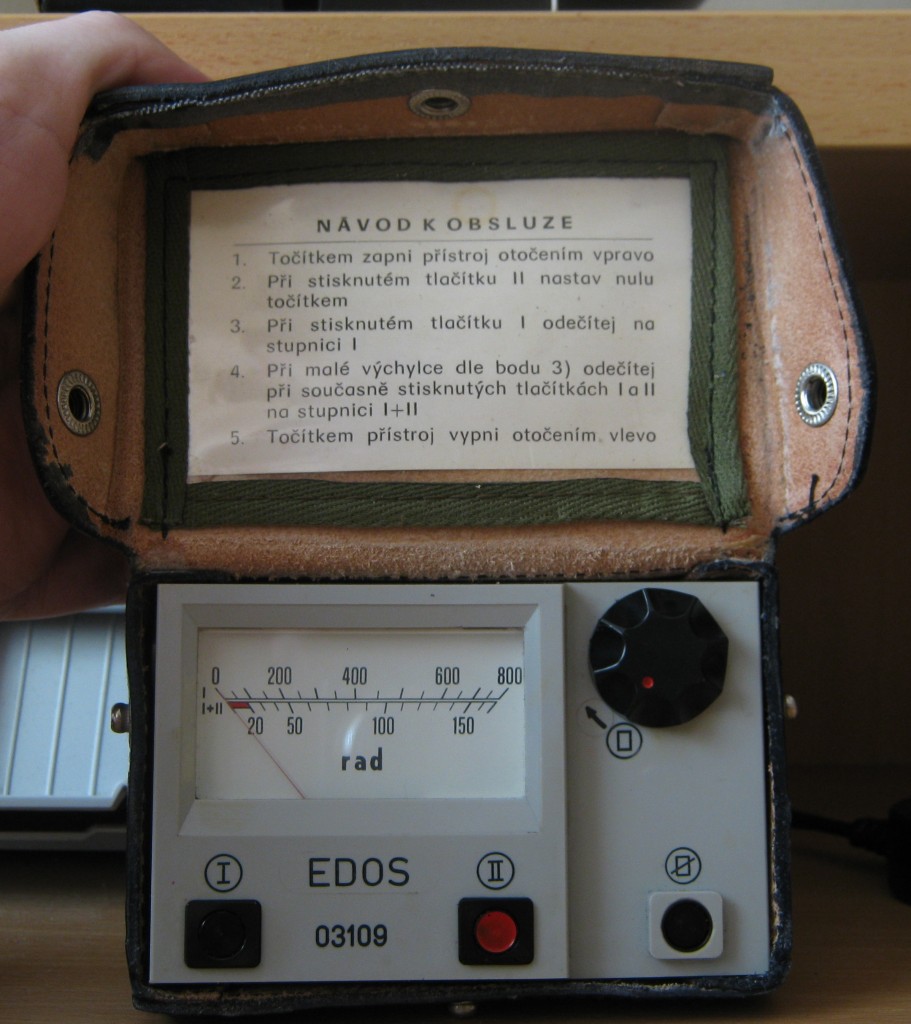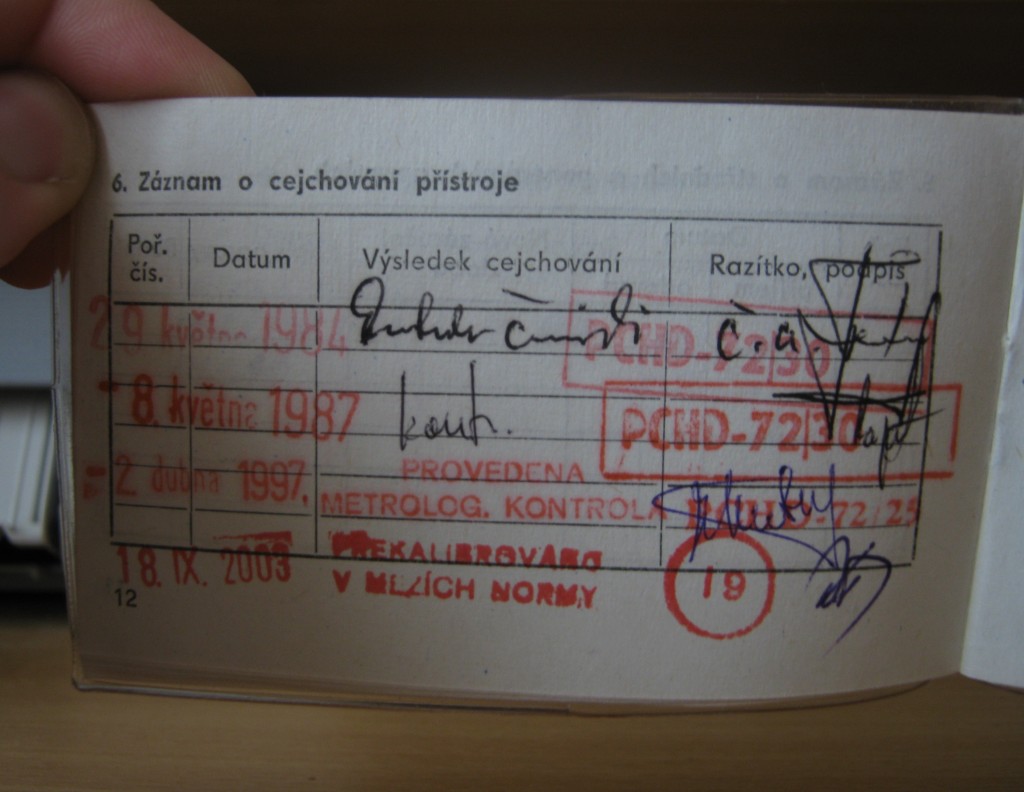
Description: Czechoslovak cumulative γ dosimeter.
Manufacturer: ČSLA
Made in year(s): 80s, my model in 1982
Country of origin: Czechoslovakia
Status: Working, last calibration in 2003
The EDOS was a special cumulative gamma dosimeter of the Czechoslovak army/civil defense branch. It came with a leather belt-on pouch and would have been used for preliminary absorbed dose measurements of irradiated materiel, or personnel, right after a nuclear explosion. Read: whether it’s safe to bury you in a cemetery, or along with radioactive waste. Except for calibration checks, it was never used in action, thankfully.
A so-called “Ohmart cell”, as the manual specifies it, is used for the detector. Basically, it’s a capacitor with gas dielectric and two (magnesium+gold) electrodes inside, all enclosed in a glass envelope with a classic “vacuum tube” NOVAL socket. A lead sheath with a hole in it was encircled around the detector. Never seen anything like it previously, so cannot elaborate more on this.
The device needs no special care and is capable of dose registration without any “pre-charging”, or even without any power source present. A single 1.5V AA cell was just used to view or erase the reading (third button did the erasing).
The operation would have been as follows: insert battery, turn the rotary switch clockwise, press and hold II button to set an exact zero with the rotary switch. Then button I, while held, would have been used to read the upper scale, whereas holding both I+II buttons for the lower scale. It was gauged in rads (centigrays), along with a little red marker between zero and twenty rads.
20 rads was the maximum asymptomatic whole body dose under wartime conditions, so now when you look at the maximum where the gauge goes, you can understand the “cemetery” part mentioned above. Especially, when the device was designed to be carried on a trouser belt.
 An Ohmart cell found inside EDOS
An Ohmart cell found inside EDOS
Photo courtesy of DANYK.WZ.CZ


Thank you, Jozef + Juergen for the Informations about the EDOS and his Ohmart-cell.
I’ve linked this page here: https://www.geigerzaehlerforum.de/index.php/topic,1317.0.html
I have an idea why it is gas filled. In Geiger counter tubes most particels interact with the gas filling and not with the tube walls which is less likely. So the electrons interacting with the plates will be secondary electrons produced in the gas.
Most likely; along with the plates of the cell being (electro-)chemically dissimilar. In the presence of a (very strong) gamma radiation that penetrates the lead sheath of the cell, there’d be voltage between the two plates, that would charge the measurement capacitor.
Thanks for the information Jozef.
So there is no internal radioactivity necessary. The incident radiation delivers the energy to charge the capacitor. But it needs an high impedance amplifier to drive the meter.
I think it works like a photocell. The incident gamma rays free electrons from the different metal plates. Electrons emitted from the magnesium have a higher average energy than from the gold. The energy of the electrons has a difference due to the different work function oft the two metals. A voltage diffence between the two plates occurs. The only thing I don’t understand is why it was gas filled.
I assumed it were a nuclear battery because other manufacturers were advertising in the same magazines with such radioactive devices to drive geiger counter tubes.
I found advertising of a company named “Ohmart” in an 1952 issue of a magazine called “Nucleonics”. They offer an instrument to measure the gamma radiation of samples in the laboratory and state that this instrument needs no high voltage power supply since it uses an “ohmart cell” . This was a radioisotope battery using Beta radiation to directly generate a charge that powers an ionization chamber. The EDOS needs no battery because it has a nuclear power source !
I’d say the Ohmart cell in this case is just a gas-filled detector that, in presence of strong gamma radiation, charges a capacitor inside EDOS. (Quoting https://patents.google.com/patent/US2964628 : “…essentially an Ohmart cell comprises three elements: a first electrode, a second electrode electrochemically dissimilar from the first, and electrically insulated from it, and an ionizable gas in contact with the two…”)
There are no isotopes inside to power EDOS, and it actually does require a battery to get the reading on the front panel meter. I’d say it’s just a transistor amplifier to get the voltage reading of said cap.
Found the principles of operation inside the original operation manual on p. 19-20 (scan available at http://danyk.cz/edos_n.jpg ). Translated from Czech:
3.3 Principles of operation
The actual detecting cell is, in practice, a cylindrical capacitor with a gas dielectric, containing metal electrodes of different electric potentials (magnesium and gold). This cell represents an electromotive force source with a very high internal resistance in a normal environment. Shall it be introduced into a field of ionizing radiation, the internal resistance drops, and the cell is charged – voltage appears on a fixed-value capacitor connected in parallel [to the cell], this voltage is in direct proportion to the dose. This operation does not require any external power source. An integral part of the device is an evaluation circuit, in operation only when reading the measurement, and is used to measure the voltage on the fixed-value capacitor without causing a voltage drop on the said capacitor.